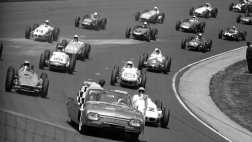In the early 1950s the Rootes Company, which owned the Hillman brand, decided to develop a range of small , four cylinder cars based around one body shell. They gave it the code name `Audax', which is Latin for 'bold'.
Then they engaged famed American design guru Raymond Lowey to style the cars. At the same time Lowey had just put the finishing touches to the 1953 Studebaker range. And guess what? Lowey designed the cars to look like shrunken `53 Studebakers.
Rootes was a master at badge engineering and they used the basic 'Audax' shell on a four door sedan, a station wagon, a two door hardtop coupe and a convertible for their Sunbeam, Singer and Hillman marques. Differing rear end and grille treatments plus varied interior appointments and engine combinations denoted the various models.
The first model out of the blocks was the 1955 Sunbeam Rapier two door hardtop. No doubt about it, this was the pick of all the styling derivates, and looks as good now as it did then. The four door Hillman Minx sedans, station wagon and convertibles went on sale in 1956. These were the entry level cars.
Singer also had a convertible model and four door sedan, known as the Gazelle. They were positioned were a little bit more up market from the Minx. The Sunbeams filled the 'sports/luxury' niche. Automatic transmission became optional in 1960. A facelift was developed for 1963, with squarer body panels. Disc brakes became standard.
In Australia, Hillman and its siblings enjoyed some success in 1950s and early 1960s but when the Ford Cortina and Vauxhall Viva arrived, with more modern styling and a cheaper price, the marque struggled. The same was reflected in the UK. Rootes itself had been absorbed into Chrysler in 1964 and the resulting change in design direction led to the Hillman Avenger and Hillman Hunter models replacing the "Audax "design.
These were also sold in Australia, with some success. And then there was the Imp. Engineered and styled as a smaller version of the rear engine Chevrolet Corvair (that was the first of its problems), the Imp was supposed to fight the Mini. Quality problems and its slightly quirky nature hampered sales.
The Hillman name disappeared in 1976 but the Hunter shape and mechanicals lived on in Iran until 2005. Known as the Paykan, they produced 2.3 million of them, making it one of the most successful car designs ever!
David Burrell is the editor of www.retroautos.com.au





.jpg)

.jpg)


_0.jpg)
 (1).jpg)

.jpg)
.jpg)


.jpg)
.jpg)
_0.jpg)



.jpg)
.jpg)
.jpg)


.jpg)
